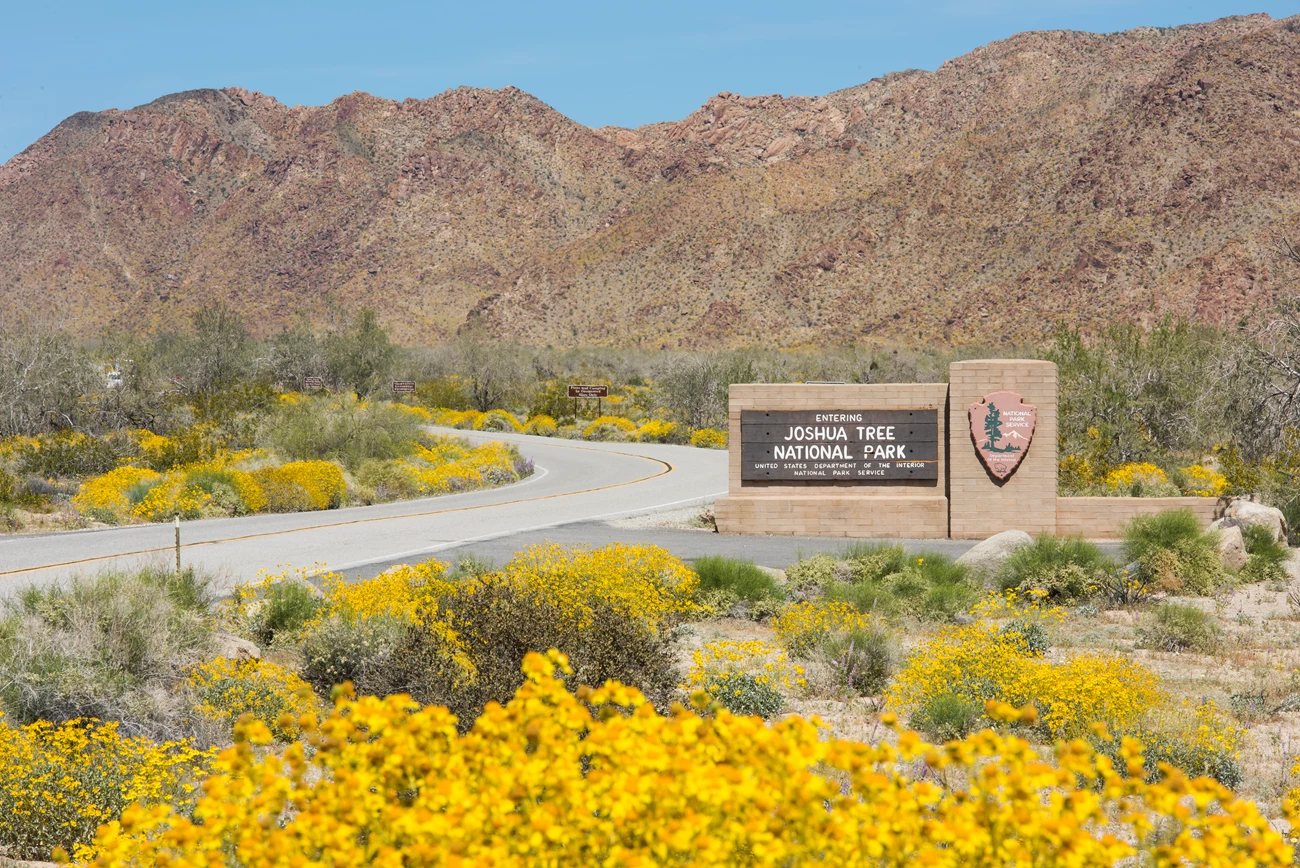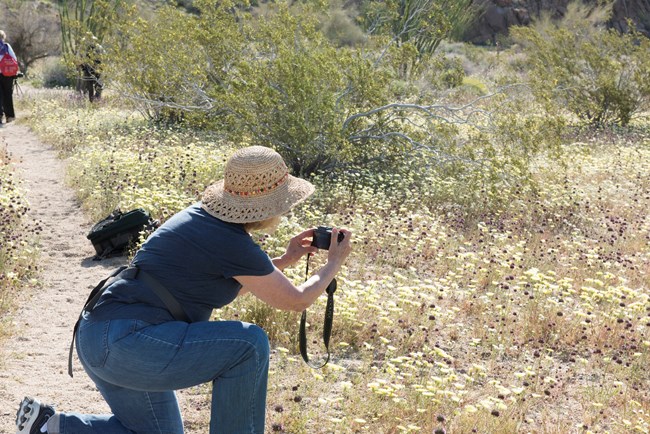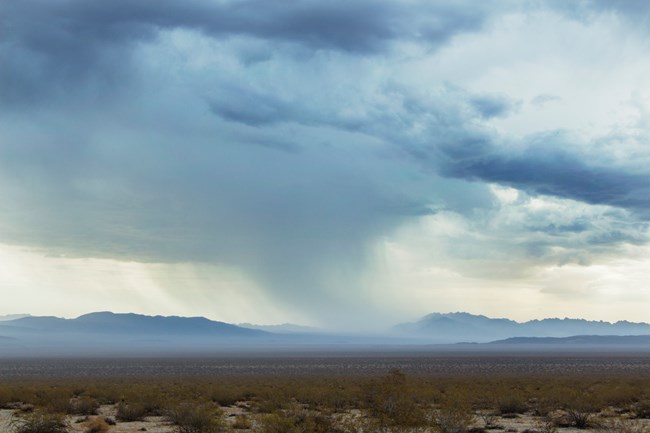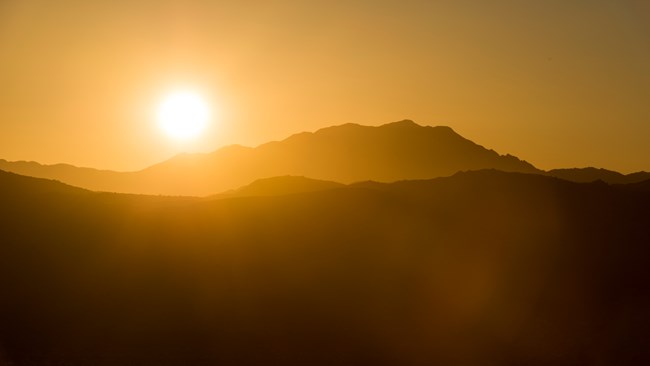
NPS Brad Sutton 
NPS/Hannah Schwalbe Tips for Wildflower ViewingLook low: Many wildflowers in the desert are extremely low growing, which conserves valuable energy and minimizes exposure to harsh conditions like strong wind and harsh sun. What’s the Forecast for Wildflowers this Year?Deserts are resilient environments where the contrast between rugged landscapes, harsh conditions, and delicate beauty captivates us. Wildflower viewing is one of the ways we can observe this dynamic, if the conditions are right. Wildflower blooms vary from year to year. To best predict whether plants will bloom in abundance in the spring, there are a few important factors to consider:

NPS/Brad Sutton Rain–The Key IngredientGentle rain that soaks deeply into the soil is essential for a desert floral display. Wildflower seeds need a half inch or more of rain during a single event to wash their protective coating off and allow them to sprout. For plants to continue growing, rainstorms must come at evenly-spaced intervals throughout the winter and spring. Early rainstorms in September or October trigger large blooms. Annual wildflower seeds will continue to thrive if an El Niño weather pattern brings above-average rainfall to the desert southwest in the late fall and winter. The park resides in the rain shadow of two of the tallest mountains in Southern California, San Gorgonio (11,503 ft or 3506 m in elevation) and San Jacinto (10,834 ft or 3302 m in elevation). This makes it more difficult for typical winter rain events, such as atmospheric rivers, to reach us. The park is a desert after all, which means it receives vastly less rain than other environments. Precipitation gauges collect rainfall data throughout the park. In the Lost Horse Valley, the average amount of rain for fall and winter is 3.61 inches. In the spring of 2019, widespread blooms occurred after the area saw 8.25 inches of fall and winter precipitation (229% of the average). 
NPS Brad Sutton Things are Heating UpSprouting wildflowers often remain small and low to the ground until the sun starts to warm the soil. They may not look like they are growing, but a strong root system is often developing below the surface. As temperatures get warmer, well-established plants will exert more energy into growing and displaying flowers. This time in a plant’s life is vital to their future. They depend on their flowers and pollinators to reproduce. A variety of insects, birds, and other wildlife visit flowers to eat nectar. While doing so, these pollinators distribute pollen to other blooms. Inadvertently, they participate in the reproduction cycle of flowering plants. The seeds from a spring bloom can remain viable for many years in the soil but require healthy growing conditions to sprout.
Harsh Desert WindFrequent springtime windstorms, without additional rain, can end or prevent a spring bloom. Dry, moving air dehydrates the exposed surfaces of all living things. Desert plants often have waxy, hairy, or spiny leaves to block the wind and hold onto precious moisture. Humans can carry and drink water as needed, but the wildflowers must retain their water. They must grow and bloom before they dry out, to leave seeds scattered on the desert floor. High wind is a common occurrence in Joshua Tree National Park. When do Desert Wildflowers Typically Bloom?Before visiting, please review these safety recommendations and current conditions to arrive prepared for your adventure. January to Mid-AprilWhere: Lower elevations on alluvial fans and foothills. These areas include the Park’s Southern Entrance, Cottonwood, and the Pinto Basin areas. Wildflowers (shown below left to right): Arizona Lupine, Desert Gold (Geraea canescens), Desert Canterbury Bells (Phacelia campanularia), and Poppies (Eschscholzia spp.) 
NPS Photos Early March to Early MayWhere: 3000 to 5000 feet elevations, upper desert slopes, canyons, and higher valleys. These areas include Hidden Valley, Indian Cove, Jumbo Rocks, and Twin Tanks areas. 
NPS Photos April through JuneWhere: 5000 + feet elevation on mountain slopes and pinyon pine/juniper woodlands. These areas include Juniper Flats, Black Rock Canyon, and the Covington Flat areas. 
NPS Photos Fall Blooms?!The Mojave and Sonoran Deserts experience periods of heavy rainfall during the summer months from monsoons. These storms often cause flash floods in the desert southwest. With this rainfall comes more potential for plant growth and flowering. Perennial and late blooming plants will take advantage of this moisture. Many of the infamous spring desert wildflowers will not begin blooming again. Some species found in these deserts are exclusively dependent on summer storms. Their blooms from late summer through fall are important components of the park’s flora. 
NPS Photos/Carmen Aurrecoechea So, Will There be a Superbloom This Year?Joshua Tree is known as a destination for spectacular spring wildflower displays, but those are the exception, not the rule. Only under perfect conditions does the desert fill with a sea of flowers. This phenomenon tends to happen once every 5 to 10 years when significantly above-average winter rainfall occurs. They are impossible to predict and may become fewer and farther between, especially with a changing climate. Although there are years where the flowers are few, they are never totally absent. Fleeting BeautyIn Joshua Tree National Park, most showy desert wildflowers are annuals, also referred to as ephemerals because they are short-lived. Oddly enough, this limited lifespan ensures survival here. Rather than struggle to stay alive during the desert’s most extreme conditions, annual wildflowers lie dormant as seeds. When enough rain does fall, the seeds quickly sprout, grow, bloom, and leave behind their seeds before the dryness and heat returns. Interested in learning more about the plants of the park? Explore the Joshua Tree National Park species list. Desert GemsJoshua Tree National Park provides habitat protection for 54 rare plant species, including two federally listed species, three on the Joshua Tree Watchlist, and 49 listed by the California Native Plant Society. Most of these rare plants are threatened beyond our boundaries by mining, off-road vehicle use, industrial-scale solar development, and increasing urbanization throughout San Bernardino and Riverside counties. Hit us with your best shot!Use iNaturalist, a free community science app for mobile devices to report your flower observations to the Joshua Tree National Park Wildflower Watch project. Your observations logged contribute valuable data to scientists all over the world. |
Last updated: July 20, 2025
